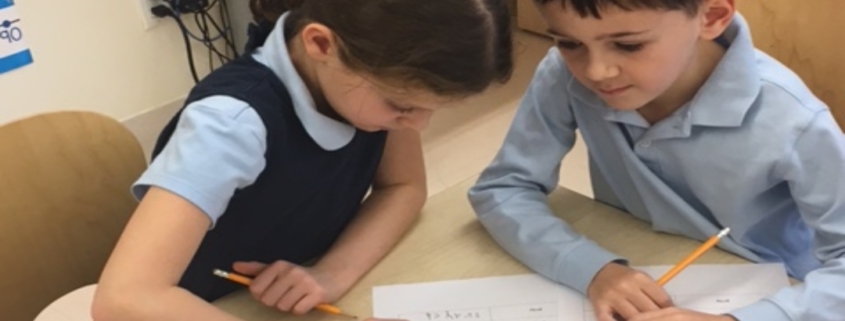Practicing Compassion: Empathy and Perspective Taking in Action
When I walked into kitah bet this week, they were discussing how compassion helps our school community. Students shared that when we show compassion to one another we feel cared for, welcomed, and supported. I was very pleased to see these 7-year-old students thinking carefully about the things to say and do to show compassion for others.
The lesson I saw comes from Second Step, a social-emotional learning curriculum used throughout the grades at Schechter Manhattan. In this lesson, the students started by considering a photo of two kids, one leaning over some markers spilled on the floor and another sitting at a desk nearby. The students were asked to consider how each of the kids in the photo was feeling and to describe how they could tell. They noticed that the kid by the markers looked sad or upset because her mouth was turned down in a frown and she seemed to have spilled her things. The kitah bet students agreed that they have had experiences like spilling something and know what it feels like to do something by accident. They then thought about what the student by the desk could say or do to show his concern and shared their ideas with each other. The teachers helped the students to connect their suggestions to the concept of empathy by explaining that compassion is empathy in action and that when you have empathy for someone you can ask yourself, “What’s a kind thing to say? How can I help?”
I believe that this sort of explicit practice of empathy is critical to nurture compassion in our students and thereby create safe and supportive learning communities. In addition, empathy is a central skill for successful development of a positive Jewish identity. In a time of divisive politics, vocal anti-Semitism, racial discord, and a growing divide between American Jews and Israel, there are many challenges to the development of a healthy and integrated American Jewish identity. I believe that key skills and dispositions for children to engage meaningfully with the complexity of these issues, and thereby build their identities, are perspective-taking and empathy. By perspective-taking, I mean the ability to hold in one’s mind both one’s own understanding of an idea or problem and someone else’s opposing view at the same time. The emotional corollary of perspective-taking is empathy, the ability to relate to someone else’s feelings. Perspective-taking and empathy are both skills that require practice to hone, and dispositions that require flexible thinking and openness to others.
The world of the 21st century is complicated. Young people without the skills and dispositions of perspective-taking and empathy, who cannot see and understand complex ideas and issues from multiple angles, will find themselves in black and white paradigms. This makes it hard for them to see how it all fits together and can lead to the rejection of a given part of their identity, communities and values. Young people who have these cognitive and emotional skills are able to apply them to their own identities, how they see themselves in the world, and bring together what can at times be conflicting traditions, experiences, and feelings into a meaningful whole.
As such, I think the Second Step lesson in kitah bet helps the students to treat each other nicely and to practice cognitive and emotional skills necessary to succeed in a complex world. With these skills, Schechter Manhattan students are able to fulfill our school mission to engage, support, and challenge one another as members of a collaborative, caring community, and confidently go forth to meet the intellectual, social, and moral challenges that lie ahead.
Shabbat Shalom.
Benjamin Mann



